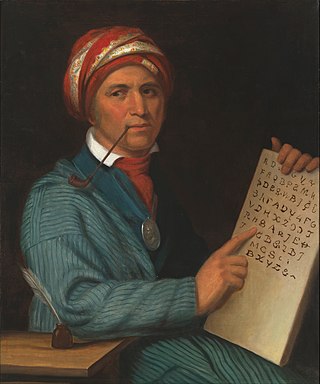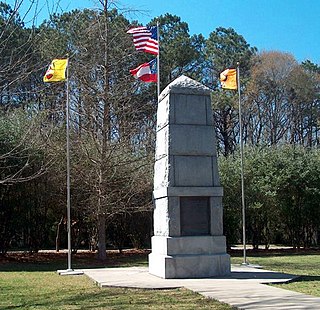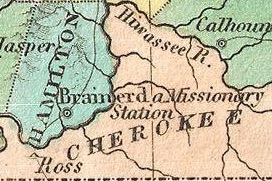
Indian removal was the United States government policy of forced displacement of self-governing tribes of Native Americans from their ancestral homelands in the eastern United States to lands west of the Mississippi River – specifically, to a designated Indian Territory. The Indian Removal Act, the key law which authorized the removal of Native tribes, was signed by Andrew Jackson in 1830. Although Jackson took a hard line on Indian removal, the law was enforced primarily during the Martin Van Buren administration. After the passage of the Indian Removal Act in 1830, approximately 60,000 members of the Cherokee, Muscogee (Creek), Seminole, Chickasaw, and Choctaw nations were forcibly removed from their ancestral homelands, with thousands dying during the Trail of Tears.

The Cherokee are one of the indigenous peoples of the Southeastern Woodlands of the United States. Prior to the 18th century, they were concentrated in their homelands, in towns along river valleys of what is now southwestern North Carolina, southeastern Tennessee, southwestern Virginia, edges of western South Carolina, northern Georgia and northeastern Alabama.

The Trail of Tears was an ethnic cleansing and forced displacement of approximately 60,000 people of the "Five Civilized Tribes" between 1830 and 1850 by the United States government. As part of the Indian removal, members of the Cherokee, Muscogee (Creek), Seminole, Chickasaw, and Choctaw nations were forcibly removed from their ancestral homelands in the Southeastern United States to newly designated Indian Territory west of the Mississippi River after the passage of the Indian Removal Act in 1830. The Cherokee removal in 1838 was brought on by the discovery of gold near Dahlonega, Georgia, in 1828, resulting in the Georgia Gold Rush.

The term Five Civilized Tribes was applied by European Americans in the colonial and early federal period in the history of the United States to the five major Native American nations in the Southeast, the Cherokee, Chickasaw, Choctaw, Muscogee, and Seminoles. Americans of European descent classified them as "civilized" because they had adopted attributes of the Anglo-American culture.

John Ross was the Principal Chief of the Cherokee Nation from 1828 to 1866; he served longer in that position than any other person. Described as the Moses of his people, Ross influenced the nation through such tumultuous events as the relocation to Indian Territory and the American Civil War.

Wilma Pearl Mankiller was a Native American activist, social worker, community developer and the first woman elected to serve as Principal Chief of the Cherokee Nation. Born in Tahlequah, Oklahoma, she lived on her family's allotment in Adair County, Oklahoma, until the age of 11, when her family relocated to San Francisco as part of a federal government program to urbanize Native Americans. After high school, she married a well-to-do Ecuadorian and raised two daughters. Inspired by the social and political movements of the 1960s, Mankiller became involved in the Occupation of Alcatraz and later participated in the land and compensation struggles with the Pit River Tribe. For five years in the early 1970s, she was employed as a social worker, focusing mainly on children's issues.

Wesley Studi is a Native American actor and film producer. He has garnered critical acclaim and awards throughout his career, particularly for his portrayal of Native Americans in film. In 2019, he received an Academy Honorary Award, becoming the first Native American as well as the first Indigenous person from North America to be honored by the academy.

(Helen) Diane Glancy is an American poet, author, and playwright.
The Trail of Tears: Cherokee Legacy is a 2006 documentary by Rich-Heape Films. It presents the history of the forcible removal and relocation of Cherokee people from southeastern states of the United States to territories west of the Mississippi River, particularly to the Indian Territory in the future Oklahoma.

Pushing the Bear is a historical novel by Diane Glancy which explores the lives of the Cherokee in 1838/39 during their forced removal from their land along the Trail of Tears in the United States. The book was published in 1996 by Harcourt.
Sharon Irla is a Cherokee artist, enrolled in the Cherokee Nation. A self-taught artist, Irla began entering competitive art shows in 2003. Her collective body of works span the fields of painting, murals, graphics, photography, and custom picture frames with Southeastern Woodlands / Mississippian motifs. The majority of her awarded works are oil-on-canvas portraits of Cherokee women in both contemporary and historical settings.

Cherokee removal, part of the Trail of Tears, refers to the forced relocation between 1836 and 1839 of an estimated 16,000 members of the Cherokee Nation and 1,000–2,000 of their slaves; from their lands in Georgia, South Carolina, North Carolina, Tennessee, and Alabama to the Indian Territory in the then Western United States, and the resultant deaths along the way and at the end of the movement of an estimated 4,000 Cherokee and unknown number of slaves, although no records of these deaths have ever materialized. Many scholars believe these Indians absconded from the removal rather than died.[citation needed]
Dana Tiger is a Muscogee artist of Seminole and Cherokee descent from Oklahoma. Her artwork focuses on portrayals of strong women. She uses art as a medium for activism and raising awareness. Tiger was inducted into the Oklahoma Women's Hall of Fame in 2001.
Robert Taylor is an American self-taught artist from Oklahoma whose paintings explore Native American subject matter. He uses symbolism and manipulates figures' proportions, particularly hands and feet.
Rachel Caroline Eaton was believed to be the first Native American woman from Oklahoma to be awarded a Ph.D.
Maggie Axe Wachacha (1892–1993) was renowned for reinvigorating Cherokee culture and for her work in ethnobotany.
Jeanne Rorex-Bridges is painter and illustrator based in Oklahoma. She is a member of the Echota Cherokee Tribe of Alabama, a state-recognized tribe.
Mary Adair is a Cherokee Nation educator and painter based in Oklahoma.

Cara Cowan Watts is a Cherokee Nation politician. She served on the Cherokee Nation Tribal Council from 2003 to 2015 and was a candidate for Principal Chief of the Cherokee Nation in the 2023 Cherokee Nation principal chief election.










